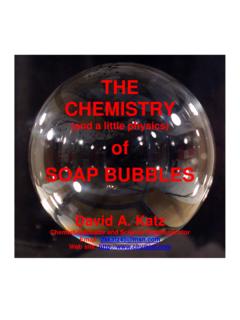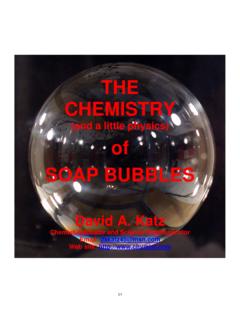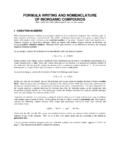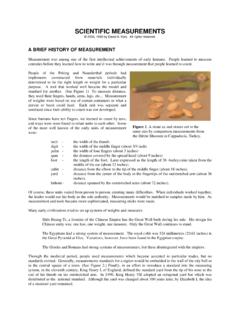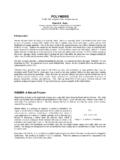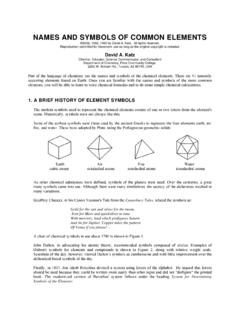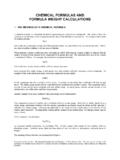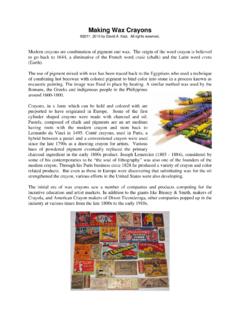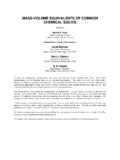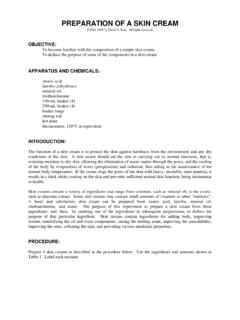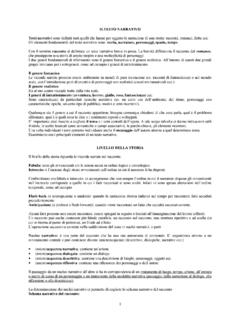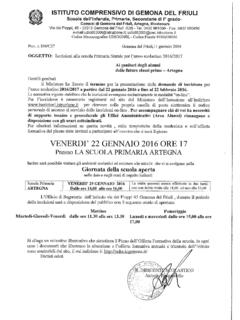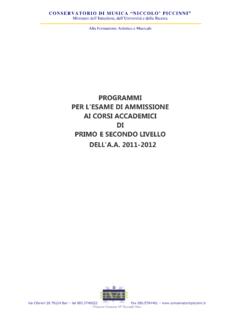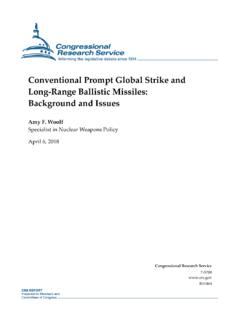Transcription of The Plan to Nuke Panama - chymist.com
1 The plan to Nuke Panama For a monumental civil-engineering job,why not use the most powerful explosive of all? by Benjamin Ryder Howe Ever since the sixteenth century, when Central America first appeared on European maps, visionaries have put forth schemes to build canals there. The first came in 1529 when a Spanish explorer named Alvaro de Saavedra suggested that a waterway might be dug by hand; by far the strangest was proposed more than 400 years later, when the United States considered blowing a trench through the isthmus using atomic bombs. This last scheme came under consideration during what was still a time of hopeful experimentation with nuclear technology.
2 The idea was to replace the 50-year-old Panama Canal, whose locks were too narrow for the world s growing fleet of supertankers and aircraft carriers, with one that would be more suited to modern conditions. The problem was not just the size of the locks but their very existence. Ships don t simply sail through the Panama Canal; they have to be lifted 85 feet to the elevation of the highest point along the way and then brought down to sea level again. Each ship s trip through requires 52 million gallons of fresh water, more than most American cities use in a day, all of it flowing through huge gravity-fed tubes.
3 The source of this water supply is a vast artificial lake whose dam provides the electrical power for the whole operation. To fill up and empty a single lock takes 40 minutes on average, and when any one of the 12 locks shuts down for maintenance, ship traffic can back up for days. Finally, with all that complicated machinery, if the canal were to be sabotaged (as had happened to the lockless Suez Canal in 1956), correcting the damage might take years. A sea-level canal would be a lot easier to operate. Besides the advantages of simplicity and ruggedness, it could accommodate ships of any size, and there would be fewer delays, shorter queues, and no need for an outside water supply.
4 The benefits of a sea-level canal had been obvious long before the original canal was undertaken, but building one would have required digging out much greater amounts of rock, a task far beyond turn-of-the-century technology. Moreover, the cut would have had to go significantly deeper, into extremely tough bedrock. Even without attempting a sea-level route, the existing canal had been an unprecedented feat of engineering, a mammoth project that, including the initial French effort, took 30 years and cost 25,000 lives. The quantity of earth moved would have been enough to build a Great Wall of China from New York to San Francisco.
5 And a sea-level canal would be a much, much bigger project. Only the advent of the atomic bomb made it seem worth considering. Not only would atomic excavation be faster and cheaper, it would also mean that engineers could choose among a wider assortment of routes, including places where mountains stood in the way of a cut. The 104-kiloton Sedan test in July 1962 left a crater 1,280 feet wide and 320 feet deep. ( DEPARTMENT OF ENERGY) Beginning in the late 1950s, Atomic Energy Commission engineers spent a decade and a half and more than $700 million on Project Plowshare, which investigated the feasibility of peaceful uses of nuclear explosions.
6 Possible applications included creating artificial harbors, building highways and reservoirs, and using detonations deep underground to bring inaccessible fossil-fuel deposits to the surface. One idea under consideration in the late 1950s was a new canal across Central America. The project received new impetus as relations grew unstable. Sites from Mexico to Colombia were studied, but most of the attention focused on eastern Panama s Dari n province, an area known for its unspoiled rain forest, cloud-covered mountains, and scant population. Although the route through Dari n was only 49 miles wide, it had been written off again and again because of its harsh environment and difficult topography.
7 The mountains, which rose along each coast, were generally no less than 1,000 feet tall. The jungle, which was flooded much of the year, seemed to stretch forever. Such conditions all but precluded a seaway built with ordinary explosives. To blow up the cut, scientists envisioned a series of underground explosions, perhaps more than two dozen, each hundreds of times as powerful as the bomb that destroyed Hiroshima. The explosions would be set off at intervals of several months and would eventually create a row of craters stretching the width of the isthmus. Side effects, including air blast, ground shock, and plumes of radioactive debris spewed in the air, would be massive.
8 There was some concern that the project might even set off an earthquake. An engineers model shows a series of detonations taking shape as a canal. (COURTESY OF LAWRENCE LIVERMORE NATIONAL LABORATORY) About 40,000 people were living in Dari n at the time, dispersed among isolated, centuries-old villages and sustained by slash-and-burn agriculture and hunting. They would have to be uprooted and relocated before excavation could begin. Moreover, the province s infrastructure would have to be built virtually from scratch: There were no roads and only a handful of dirt airstrips, which were used by missionaries and government inspection teams.
9 How seriously was the project considered? Today it seems the epitome of scientific hubris, but according to Lynn Anspaugh, a biophysicist who worked on the nuclear-excavation concept at Lawrence Livermore National Laboratory in the 1960s, the dangers involved in blowing up part of the isthmus were not that big. Anspaugh says he and his colleagues were unable to prove that nuclear excavation was either feasible or safe, but he adds: The risks were not a showstopper. Probably they could have been managed. Basically, if you can move the population out of the way, all you re doing is throwing around a lot of soil.
10 So I would say the scientists took the idea very seriously. What kept the project from advancing further, Anspaugh says, was the inability to carry out sufficient testing. Small-scale tests had begun in September 1957 but were halted in the fall of 1958, when a voluntary test ban went into effect. The ban lasted almost three years. When the ended it in August 1961, the United States resumed its test detonations, such as Project Sedan, a July 1962 shot in Nevada that left a crater in the desert four times as big as the Louisiana Superdome. But more work was needed, and since the project was not kept secret, growing public concern over the health effects of nuclear testing in populated areas impeded the development of clean explosives bombs relying mostly on fusion, rather than fission, in order to decrease fallout as well as techniques to produce craters of specific shapes and sizes with multiple simultaneous detonations.
